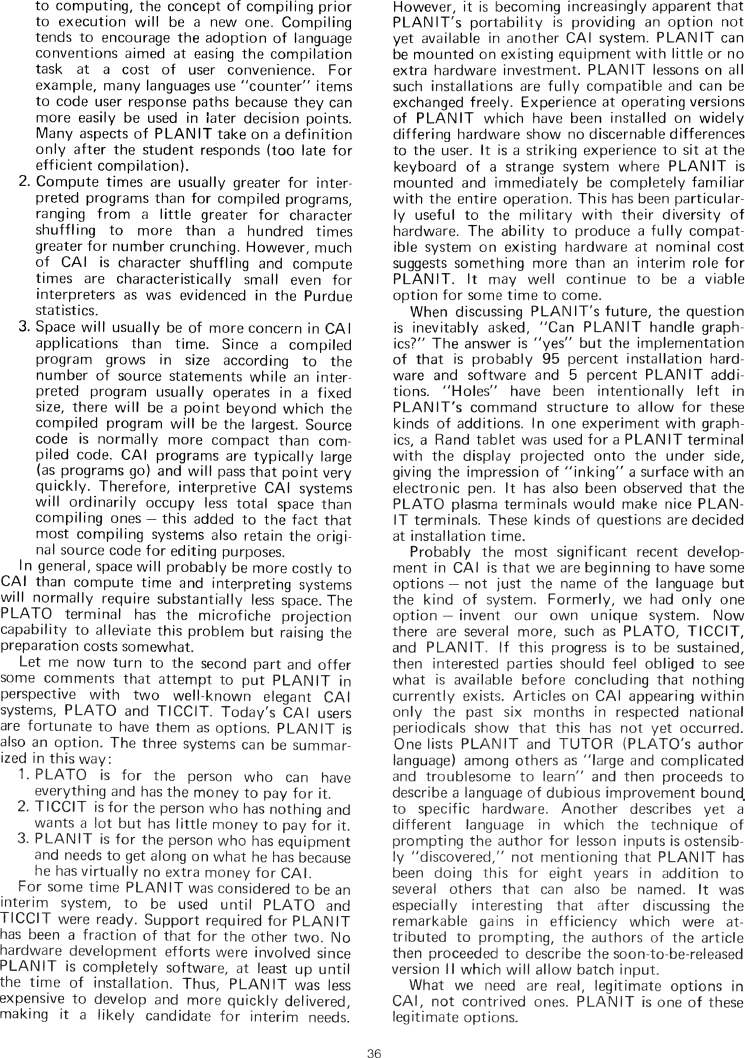The Best of Creative Computing Volume 1 (published 1976)
PLANIT: The Portable CAI System

to computing, the concept of compiling prior to execution will be a new one.
Compiling tends to
encourage the adoption of language conventions aimed at easing the compilation
task at a cost of user convenience. For example, many languages use "counter"
items to code user response paths because they can more easily be used in later
decision points. Many aspects of PLANIT take on a definition only after the
student responds (too late for efficient compilation).
2. Compute times are usually greater for interpreted programs than for compiled
programs, ranging from a little greater for character shuffling to more than a
hundred times greater for number crunching. However, much of CAI is character
shuffling and compute times are characteristically small even for interpreters
as was evidenced in the Purdue statistics.
3. Space will usually be of more concern in CAI applications than time. Since a
compiled program grows in size according to the number of source statements
while an interpreted program usually operates in a fixed size, there will be a
point beyond which the compiled program will be the largest. Source code is
normally more compact than compiled code. CAI programs are typically large (as
programs go) and will pass that point very quickly. Therefore, interpretive CAI
systems will ordinarily occupy less total space than compiling ones - this added
to the fact that most compiling systems also retain the original source code for
editing purposes.
In general, space will probably be more costly to CAI than compute time and
interpreting systems will normally require substantially less space. The PLATO
terminal has the microfiche projection capability to alleviate this problem but
raising the preparation costs somewhat.
Let me now turn to the second part and offer some comments that attempt to put
PLANIT in perspective with two well-known elegant CAI systems, PLATO and TICCIT.
Today's CAI users are fortunate to have them as options. PLANIT is also an
option. The three systems can be summarized in this way:
1. PLATO is for the person who can have everything and has the money to pay for
it.
2. TICCIT is for the person who has nothing and wants a lot but has little money
to pay for it.
3. PLANIT is for the person who has equipment and needs to get along on what he
has because he has virtually no extra money for CAI.
For some time PLANIT was considered to be an interim system, to be used until
PLATO and TICCIT were ready. Support required for PLANIT has been a fraction of
that for the other two. No hardware development efforts were involved since
PLANIT is completely software, at least up until the time of installation. Thus,
PLANIT was less expensive to develop and more quickly delivered, making it a
likely candidate for interim needs.
However, it is becoming increasingly apparent that PLANIT's portability is
providing an option not yet available in another CAI system. PLANIT can be
mounted on existing equipment with little or no extra hardware investment.
PLANIT lessons on all such installations are fully compatible and can be
exchanged freely. Experience at operating versions of PLANIT which have been
installed on widely differing hardware show no discernable differences to the
user. It is a striking experience to sit at the keyboard of a strange system
where PLANIT is mounted and immediately be completely familiar with the entire
operation. This has been particularly useful to the military with their
diversity of hardware. The ability to produce a fully compatible system on
existing hardware at nominal cost suggests something more than an interim role
for PLANIT. It may well continue to be a viable option for some time to come.
When discussing PLANIT's future, the question is inevitably asked, "Can PLANIT
handle graphics?" The answer is "yes" but the implementation of that is probably
95 percent installation hardware and software and 5 percent PLANIT additions.
"Holes" have been intentionally left in PLANIT's command structure to allow for
these kinds of additions. In one experiment with graphics, a Rand tablet was
used for a PLANIT terminal with the display projected onto the under side,
giving the impression of "inking" a surface with an electronic pen. It has also
been observed that the PLATO plasma terminals would make nice PLANIT terminals.
These kinds of questions are decided at installation time.
Probably the most significant recent development in CAI is that we are beginning
to have some options - not just the name of the language but the kind of system.
Formerly, we had only one option - invent our own unique system. Now there are
several more, such as PLATO, TICCIT, and PLANIT. If this progress is to be
sustained, then interested parties should feel obliged to see what is available
before concluding that nothing currently exists. Articles on CAI appearing
within only the past six months in respected national periodicals show that this
has not yet occurred. One lists PLANIT and TUTOR (PLATO's author language) among
others as "large and complicated and troublesome to learn" and then proceeds to
describe a language of dubious improvement bound to specific hardware. Another
describes yet a different language in which the technique of prompting the
author for lesson inputs is ostensibly "discovered," not mentioning that PLANIT
has been doing this for eight years in addition to several others that can also
be named. It was especially interesting that after discussing the remarkable
gains in efficiency which were attributed to prompting, the authors of the
article then proceeded to describe the soon-to-be-released version II which will
allow batch input.
What we need are real, legitimate options in CAI, not contrived ones. PLANIT is
one of these legitimate options.


